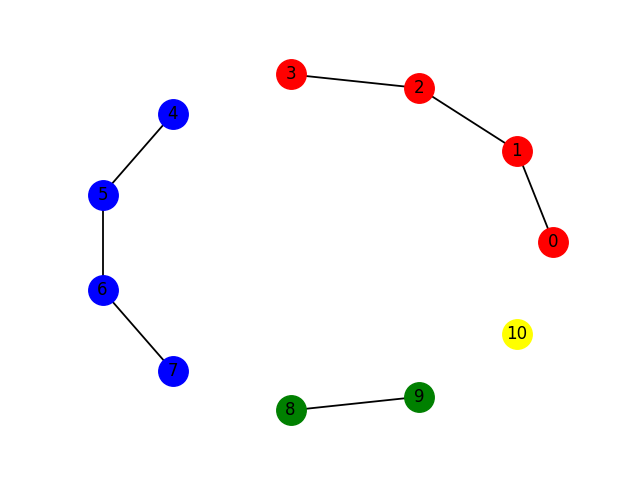Note
Click here to download the full example code
Connected Components¶
In this example we demostrate how to find connected components in undirected graphs.
Start by importing the package.
import jgrapht
import jgrapht.algorithms.connectivity as cc
import jgrapht.drawing.draw_matplotlib as drawing
import matplotlib.pyplot as plt
We start by creating a graph with 4 connected components.
g = jgrapht.create_graph(directed=False, weighted=True)
for i in range(11):
g.add_vertex(i)
g.add_edge(0, 1)
g.add_edge(1, 2)
g.add_edge(2, 3)
g.add_edge(4, 5)
g.add_edge(5, 6)
g.add_edge(6, 7)
g.add_edge(8, 9)
print(g)
Out:
({0, 1, 2, 3, 4, 5, 6, 7, 8, 9, 10}, {0={0,1}, 1={1,2}, 2={2,3}, 3={4,5}, 4={5,6}, 5={6,7}, 6={8,9}})
Then, we execute the connected components algorithm.
is_connected, connected_components_it = cc.is_connected(g)
connected_components = list(connected_components_it)
The result is a tuple which contains whether the graph is connected and an iterator over the connected components.
print('is connected: {}'.format(is_connected))
for i, cc in enumerate(connected_components):
print('Connected component {}: {}'.format(i, cc))
Out:
is connected: 0
Connected component 0: {0, 1, 2, 3}
Connected component 1: {4, 5, 6, 7}
Connected component 2: {8, 9}
Connected component 3: {10}
Ploting the graph with a circular layout and separate color per connected component.
positions = drawing.layout(g, name="circular", seed=17)
vertex_labels = {v:str(v) for v in g.vertices}
colors = ['red', 'blue', 'green', 'yellow']
for cc, color in zip(connected_components, colors):
drawing.draw_jgrapht_vertices(g, positions=positions, vertex_list=cc, vertex_color=color)
drawing.draw_jgrapht_vertex_labels(g, positions=positions, labels=vertex_labels)
drawing.draw_jgrapht_edges(g, positions=positions)
plt.show()

Total running time of the script: ( 0 minutes 0.113 seconds)